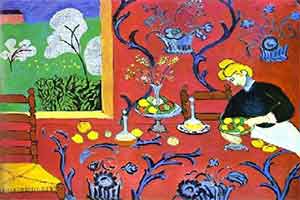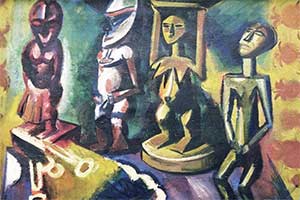Matisse. An attack of appendicitis changed a possible lawyer in an extraordinary painter

At the Scuderie del Quirinale – Rome
5 March to 21 June 2015
by Prof, Francesco Carelli, Milan,. Rome, Cluj-Napoca, London
Henri Matisse told critic Gaston Diehl in a letter dated 1947 that “la révélation m’est venue d’Orient”: but this revelation was by no means a sudden shock. As we can tell from his paintings and drawings, it was spawned by a growing familiarity with the Orient and gradually developed in the course of the artist’s travels, encounters and visits to exhibitions and shows.
Hosted by the Scuderie del Quirinale and promoted by the Ministero dei Beni e delle Attività Culturali e del Turismo and by Roma Capitale, the exhibition shows over one hundred works by Matisse, including several of his most outstanding masterpieces , from some of the world’s leading museums such as the Tate, the MET, the MoMa, the Pushkin, the Hermitage, the Centre Pompidou, the Orangerie, Philadelphia and Washington, to mention but a few.
Matisse Arabesque aims to offer visitors a perception of the influenced exercised by the Orient on the painting of Matisse – an Orient which, with its artifice, its arabesques and its colours, suggests a vaster space, a truly plastic space, infusing his compositions with a new breadth, freeing it from all formal constraint, from the need for perspective and for “lifelikeness”, opening up a space made of vibrant colours, a novel conception of decorative art resting on the idea of pure surface.
Henri Matisse was not born to become a painter – “I am the son of a seed merchant, and I was supposed to take over the business and run it in my father’s place” – in fact, he set out on a career as a lawyer before becoming an artist. It was his health that altered the course of history. He was working as a clerk in a legal practice in Saint-Quentin in 1890 when a bad attack of appendicitis put him on his back for almost a year. He took up painting, and began to frequent symbolist painter Gustave Moreau’s studio with his friend Albert Marquet in 1893, going on to officially enrol at the École des Baux Arts, where the teaching staff included numerous Orientalists, in 1895.
He saw a great deal of the Orient in these years, visiting the Louvre’s vast collection of Islamic art on permanent display as well as the various exhibitions devoted to Islamic art hosted by the Musée des Arts Decoratifs in Paris, in 1893–4 and especially in 1903. At the Exposition Universelle in 1900 Matisse discovered the Muslim countries themselves in the pavilions devoted to Turkey, Persia, Morocco, Tunisia, Algeria and Egypt. He also frequented such avant-garde galleries as that of Ambroise Vollard, where in 1899 he purchased a drawing by Van Gogh, a plaster bust by Rodin, a picture by Gauguin and a painting by Cézanne, who was to have a major impact on his work.
Matisse travelled to Algeria in 1906, bringing back the ceramics and prayer mats that were to fill his canvases with their designs and colours from that time on. In 1907 he visited Florence, Arezzo, Siena and Padua: “When I see Giotto’s frescoes, I am not concerned to find out which scene of the life of Christ I have before my eyes, but I perceive instantly the feeling which radiates from […] the composition in every line and colour”. His visit to the great “Exhibition of Mohammedan Art” in Munich in 1910 – the first exhibition of Muslim art that was to influence a whole generation of artists from Kandinsky to Le Corbusier – was what truly inspired him to develop a form of decoration based on a style of composition light years distant from Western tradition. Travelling to Moscow in the autumn of 1911 to oversee the installation of his La Danse and La Musique in Sergei Shchukin’s home, Matisse returned to Africa in 1912, this time to Morocco and in particular to Tangier “la blanche“. It was here that the tailleur de lumière, as his son-in-law Georges Duthuit was to nickname him, was bewitched by the soft light and lush vegetation that were to underscore his harmonious, almost musical cadence: “One tone is just a colour; two tones are a chord, which is life”.
Morocco, the Orient, Africa and Russia in their most intensely spiritual essence, their essence most distant from the purely decorative dimension, were to suggest new compositional patterns to Matisse. The arabesques and intricate geometrical designs found in the Ottoman world, in Byzantine art, in the Orthodox world and in the early painters whose work he had studied in the Louvre were all elements that Matisse interpreted in an extraordinarily modern manner, formulating an artistic vocabulary which ignored the precision of natural forms in order to brush with the sublime.
Visitors are greeted in the first room by Matisse’s monumental Calla Lilies, Irises and Mimosas dated 1913 from Moscow’s Pushkin Museum, a work that heralds the magical palette of blues and greens which Matisse borrowed from the world of oriental decoration, particularly from the 15th and 16th century Ottoman and North African ceramics dominated by the symbolic depiction of nature.
The next room takes visitors into the totally different world of primitivism, for which Matisse had a true infatuation, and of his passion for collecting African masks and fabrics. His palette becomes darker and his strokes simpler and more geometric, for instance in the Portrait of Yvonne Landsberg dated 1914, a masterpiece from the Philadelphia Museum of Art, and the visually close Demoiselles d’Avignon dated 1907, a revolutionary icon in the development of 20th century art.
These two paintings sit alongside a series of outstanding portraits showing how Matisse’s style became increasingly unfussy and essential, from the Italian Woman dated 1916 from the Solomon R. Guggenheim Museum in New York, to the Girl with a Persian Cap dated 1915–16 from The Israel Museum in Jerusalem and the Three Sisters dated 1916–17 from the Musée de l’Orangerie in Paris, where the primitive mood is designed to help visitors grasp Matisse’s fascination with African objects, masks and fabrics.
The Mediterranean world explodes in all its most dazzling colours, through Morocco and Matisse’s ties with the Muslim world ( he owned fabrics from all the regions of the world, which he used to paper the walls of his studio in imitation of a nomadic tent ). In his celebrated picture of Zohra on the Terrace dated 1912 from the Pushkin Museum in Moscow, in his Moroccan in Green, also dated 1912 from the Hermitage– Matisse achieves a “textile” effect in his painting through an extreme simplification of image combined with an exuberant palette, which reaches here its sharpest notes.
In Room Five visitors can be surprised by a less well-known side of Matisse, with three outstanding landscapes from the 1910s: Periwinkles / Moroccan Garden dated 1912 from the MoMA in New York, Trivaux Pond dated 1916 from the Tate in London and Palm Leaf, Tangier dated 1912 from the National Gallery of Art in Washington, all of which reflect the influence of his travels to Morocco and in all of which he achieves a synthesis of chromatic inlay on the dominant notes of green and pink. These landscapes are accompanied in the room by a number of Matisse’s illustrations, his etchings with their regular and extremely fine strokes for Mallarmé’s book of poems in 1932. Discussing these illustrations, Matisse said: “The problem was to balance each pair of facing pages – the one with the etching white, the other with the typography relatively black. I achieved this by modifying my arabesques in such a way that the spectator’s attention would be interested as much by the entire page as by the promise of reading the text.”
Amongst all the Muslim vases, the precious Oriental fabrics and the cages with white turtle doves, one would often encounter also a model in Matisse’s studio. Fascinated by the relationship between the female body and the studio environment, which invariably resembled a stage set, Matisse portrayed the magical charm of odalisques reclining, seated or standing, and of arabesqued fabrics, underscoring the play of lines invading space in a seductive explosion of colour. We encounter the mysterious allure of his Blue Odalisque dated 1921 from the Orangerie in Paris, the sensuality of his Two Models Resting dated 1928 and of his Moorish Screen dated 1921, both from the Philadelphia Museum of Art, and a selection of extremely sophisticated and masterly drawings of female profiles in the enigmatic poses and rich dress of the odalisque.
Matisse’s travels return to the fore in the following room, with echoes of European decorative motifs such as the Spanish costume in his energetic Spanish Dancer dated 1909 from the Pushkin Museum, or the yellow dress worn by Katia, dated 1951, from the Pierre and Tana Matisse Foundation in New York.
Like so many other artists of his era including Picasso, Matisse also worked with Diaghilev’s Ballets Russes. In this exhibition we see him turning his hand to costume design. To the accompaniment of Stravinsky’s music, the exhibition space is filled with the costumes for Le Chant du Rossignol, which he designed in 1920 for the ballet choregraphed by Léonide Massine, a kind of “total work” in which ballet, music and painting were all congregated in a single fantastic vision.
The last room gives us a further glimpse of Matisse’s minimalistic style in a series of astonishing studies and drawings of leaves, trees and plants with their immense surfaces. These are as powerful as fully-fledged paintings, particularly the Buisson dated 1951 from the Fondation Maeght or the Tree dated 1951 from the Centre Pompidou, which are hung on the wall in such a way as to recreate a vast forest of plant life in a crescendo that culminates in The Goldfish, Matisse’s celebrated and unparalleled masterpiece from the Pushkin Museum, dated 1912.
With its allusion to items from the rich and sumptuous figurative cultures mentioned above and to hybrid combinations and a cross-contamination of genres and styles, this exhibition endeavours to breathe new life into the luxury and the delicacy of ancient worlds, enhanced by the deep and visionary yet extraordinarily contemporary take of the immense genius that was Henri Matisse.



